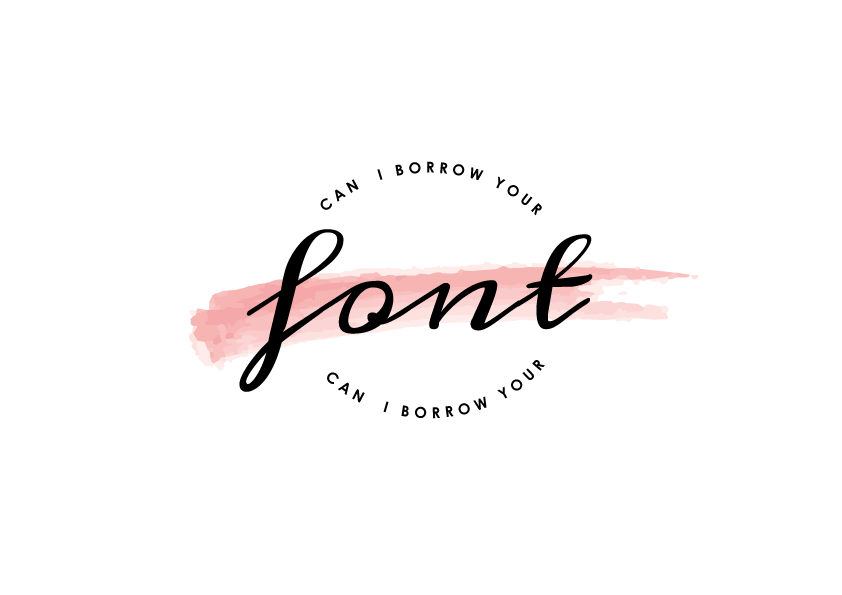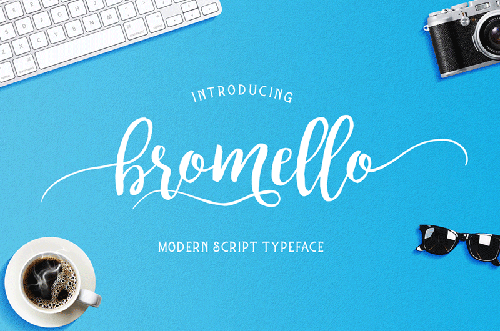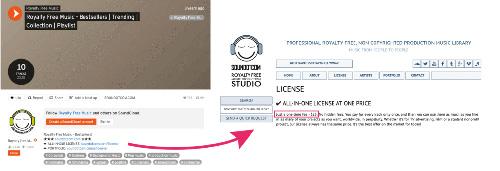

Have you met this woman before? I bet so. She is present in countless advertising campaigns (proof of it here), so you probably assumed that she was your fellow compatriot. Well, unless you’re from Canada, it’s not the case. She is Rebecca Givens, the quintessential stock photography model.
Fashions come and go, but she remains.
In this sense, there is a graphic style that has been in fashion for a while and that seems to come to stay: the use of calligraphic fonts (hand lettering), especially for dissemination campaigns and advertisements (a couple of examples here).
And there is one, in particular, that seems to be becoming the Rebecca Givens of the fonts. This is Bromello, created by professional artist Alit Suarnegara (Alit Design).

Normally, when a trend rises to such great heights of popularity, all market agents tend to accommodate to it, adapting their systems for rapid metabolization. This goes from the most avant-garde (who will already be fleeing from it) to the smallest (the overwhelming majority). Local tastes will make its sedimentation take place sooner or later, but globalization (which sets the standards based on the vast offer provided by the Internet) will make its arrival at your nearest billboard almost inevitable. And Latin America is no exception.
Because digitalization has provided new ways of doing business, even more vertiginous in its alterations (shorter life-cycles), and more capricious (with novelty as a paradigm, although the new is the retro/vintage) in its accruals (this is modernity, my friends), which has dragged entrepreneurs into an exhausting visibility and building and rebuilding of brand image system.
This translates into the generation of audiovisual content of acceptable quality at a frequency that, realistically, prevents amortization of the really necessary investment so that there are no problems at an Intellectual Property level. Why? Because instead of an agency with staff and knowledge in the field that guarantees a clean product, it is hired a freelance (who is quite busy trying to survive) or -at best- it is assigned to in-house staff (more or less qualified) in multitask mode to produce images, videos and texts for social networks or the company’s website; catalogues; promotional videos; product presentations; posters and merchandising; and, even, redesign of corporate image, including the logo (present in the signature of the email, folders, premises, products, etc.)
But you should bear in mind that -almost all of- this type of material is protected by Copyright, and that “accessible” does not mean “free of charge”.
In this sense, a multitude of freemium tools has emerged intending to make life easier for other entrepreneurs (and make a living from it). From bank of images (e.g. Pixabay, Unsplash or Shutterstock), videos (Openshot, Avidemux or iMovie), music (e.g. Soundcloud or Epidemicsound), infographics (Piktochart, Biteable or Mural) or fonts (i.e. Dafont) to websites and editing apps for social networks.
And in each of them provide the terms and conditions of use (also known as “licenses”) of these images.
In this sense, “Copyright-free” or “royalty-free” are tags that facilitate the search, but the songs, videos, illustrations, etc. still belong to their creator, who allows their use according to those terms and conditions (e.g. attribution of authorship, modification prohibited, etc.).
However, when you face these licenses, you can see that there are two predominant formats:
a) Simplified: with a system of icons and three or four very widespread aspects, with no specification about explicit applications, such as Creative Commons.
b) Hyper-disclaiming: long texts loaded with timeless-intended, legal language elaborated to ease the conscience of its editors and make the users dizzy, where the current regulations applicable is en bloc referred and simplistic examples are given.
None of them give a conclusive answer and they require a prior thorough knowledge of Intellectual Property to decipher them, but at least the first leaves a sense of security (I got it; I know what I can do; It is legal) that the latter snatch (What did I just read?; It might be risky; It is legalistic).
Furthermore, the title or description of the copyright-protected content can contradict the type of license selected.

Eventually, the song was not for free (US$ 25), according to the license
What can you do to benefit from the resources offered by the Internet understandably and safely?
Let’s go back to the aforementioned font. This case is especially illustrative because it is a resource:
- much in demand
- very versatile
- very accessible
- not so easy to track
Let’s suppose you want to launch a Black Friday campaign and that you want to use the font Bromello. First, you’ll go to one of the web pages where it is offered, download it (thereby accepting the license terms) and create your poster.
The result would not allow distinguishing what type of license the font had (personal use only; standard, professional or extended), so it is very tempting to select the first one (free) and operate as if you got the extended version. Sometimes, multimedia content incorporates Technological Protection Measures to avoid abusive uses (e.g. it is distorted when printing or only allows reading when rasterized) or the platforms where they are uploaded have their technology (e.g. YouTube uses Content ID ), but this is not the case.
YouTube has been updating its formula, eliminating the “type of license” category, letting users incorporate the text they deem appropriate in the description (here is a very good example) and investing in copyright-friendly policies
However, Mr. Suarnegara, proud that his creation is part of a colorful campaign, could contact you to congratulate you, request license information and, if necessary, take legal action for copyright infringement.
Really? For a single-day campaign? Of course. That was the case of two news agencies that used photographs taken in Haiti after the fateful 2010 earthquake (owned by a freelance photographer and published on his Twitter account) without his permission (more information here). The result: US$1.2 million as compensation for the copyright holder.

In addition to the Copyright regulations, you must take into account that of Trademarks (of which they may appear in the images, for example), data protection and the right to privacy and own image.
To avoid this, it is recommended to follow the following tips, which are also applicable to stock images (even Rebecca’s) or any other copyright-protected content available online:
- Select reliable content sources
- Know how will it be used and apply filters by type of use (commercial, non-commercial, with modification, etc.)
- Check if the author is clearly identified on the website
- Review the terms of use of the website and make sure they are understandable
- Document the source of the content so that its origin can be verified
- Create a database with sources and licenses
- In case of doubt, contact the author or discard that content
In the case of Bromello, going to Dafont, Creative Market or the artist’s own website is a good option, because in all of them it is perfectly explained what can be done and what cannot.
Creative Market arranges the information in the best possible way (find out more here) and can be described as a good practice. Why? Check this out:
- Simple disclaimer with links to extended information clearly separated according to its complexity
- Table with the most common options (do’s and dont’s)
- FAQs (including use for logos registered as trademarks)
- Extended version
- Contact information for special licenses and inquiries
As you may have noticed, none of these companies is located in a Latin American country. So what’s the point? Copyright regulations establish that your work’s protection is born with creation (registration is not required to have an exclusive right, in contrast to Trademarks or Patents).
This is so in Europe and Latin America. But it also happens that all the countries they cover are part of the Berne Convention, so that protection is applied in all these territories “automatically” and reciprocally. Therefore, if your company creates content that is protected by Copyright, a Colombian or Brazilian user is obliged to respect your proprietary rights and vice versa.
But, watch out! That does not mean that regulations are identical on both sides of the Atlantic ocean since in Latin America many countries have not adapted their regulations to the needs imposed by new technologies (although they are underway).
You have to pay attention to local particularities if you want to succeed in Latin America and the Latin America IPR SME Helpdesk is here to provide you with valuable support.
So if you want to know more about the status of Copyright in Latin America, ask our experts or look at our Factsheets on Copyright in the Andean Community, Copyright in a Nutshell or Copyright in a Nutshell II.
Details
- Publication date
- 12 September 2019
- Author
- Executive Agency for Small and Medium-sized Enterprises
